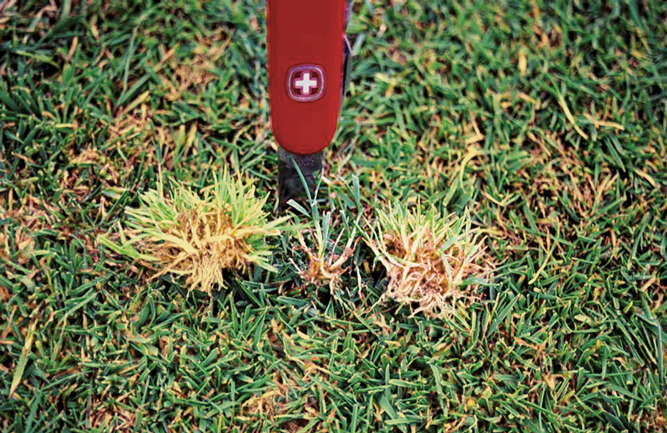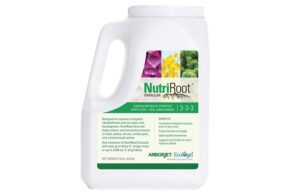Experts Insights: Yellow tuft and downy mildew molds control and avoidance

Yellow tuft rarely kills turf, but it can discolor greens, tees and fairways. (Photo courtesy of Pete Dernoeden)
Yellow tuft is a disfiguring disease that seldom kills turf. In St. Augustinegrass, the disease is called downy mildew since the tufting symptoms are absent.
Identification: Yellow tuft is incited by Sclerophthora macrospora, a highly sophisticated obligate parasite and member of the water mold family. This pathogen attacks nearly all turfgrasses, as well as several major grass crops, including rice and corn.
On golf greens, tees and fairways, the disease appears as yellow spots, 0.25 to 0.5 inch (6.2 to 12.5 mm) in diameter. In Kentucky bluegrass and other wider-bladed grasses, yellow spots are 1 to 3 inches (25 to 75 mm) in diameter. In low areas where water collects and puddles, infected stands may exhibit a generalized chlorosis.
Each spot consists of one or two plants having numerous tillers, giving plants a tufted appearance. The tufting, or abnormal tiller production, induced by S. macrospora causes a shift in the production of a hormone that regulates tillering. Roots of infected plants are short and bunchy, and tufts are easily detached from the turf.
During cool and moist periods in late spring and autumn, plants develop a yellow color. The yellowing is the indirect result of a heavy fruiting body (sporangia) and subsequent spore production by the fungus. Once leaves dry, sporangia desiccate and, when abundant, appear as a white residue on leaves.
These spores (i.e., zoospores) swim, so yellow tuft is more severe in low-lying areas where water puddles. Infected plants may die, but only when subjected to other stress factors.
In St. Augustinegrass, the disease is called downy mildew, and the symptoms are different. The disease appears as white, linear streaks that run parallel to leaf veins. Leaves turn yellow, and there may be some browning of leaf tips. Excessive tillering does not occur. The disease is disfiguring, and St. Augustinegrass growth may be stunted. In zoysiagrass, however, the yellow tuft symptom is common.
Conditions: Symptoms of yellow tuft are most prominent during spring and autumn since the disease is promoted by extended periods of cool and wet weather. Seedlings are most vulnerable to infection by S. macrospora, which accounts for why the disease is most commonly observed in the spring following autumn seeding.
Yellow tuft recurs in older turfs following excessively wet weather in spring and autumn. During most summer months, infected plants appear green and healthy.
Control: Vertical cutting golf greens in spring will physically detach many tufted plants. Improving surface water drainage helps to alleviate yellow tuft since the disease is most severe in low areas where water collects.
Yellow tuft is best controlled with mefenoxam. Mefenoxam performs better when it is tank mixed with fludioxonil. Two or three mefenoxam applications may be required to eradicate the fungus.
After fungicide application(s), however, plants can retain their tufted appearance for several weeks. It is only until new tillers replace the older infected shoots that plants regain their normal appearance and growth habit.
Mefenoxam works best when applied preventively and prior to rainy weather, particularly where there are seedlings or immature plants. There may be little response from a curative mefenoxam application if it is not tank mixed with fludioxonil.

Brett Rieck
PBI-Gordon Corp.
Brett Reick
Regional manager
Yellow tuft is not a common disease. There aren’t a lot of research dollars dedicated to it, like dollar spot or Pythium. Yellow tuft hits most commonly in greens when wet, cool conditions are prevalent. Geography doesn’t matter; it just needs those cool, wet conditions. It almost looks like a mildew. Turf turns yellow in patches, or it just looks off-color. Some forms attack nurseries or greenhouses, but in golf, we worry about greens. It can hit fairways, but people don’t treat for it there.
Chemically, curative applications aren’t going to work, you have to apply preventively. Mefenoxam, cyazofamid or fosetyl are good to prevent it. It’s an interesting, unique disease, like red thread, and yellow tuft is a pain.

Mike Agnew, Ph.D.
Syngenta
Mike Agnew, Ph.D.
Technical services manager
Yellow tuft is a disease caused by Stenotaphrum secundatum. While it is known to affect all turfgrass species, it is most notable in annual bluegrass and bentgrass greens. Infection occurs during cool, wet weather in spring and fall and is most severe in low, wet areas. Symptoms appear as yellow spots of tufted plants 0.25 inch to 1 inch in diameter. Leaves and tillers are yellow and clustered as a result of an abnormal, fungal-induced proliferation of tillers. Tufts are easily detached from turf, exposing clusters of short, stubby roots. In St. Augustinegrass, there is no tufting. The disease appears as white streaks parallel to the leaf veins. Yellow tuft is an obligate parasite that survives and reproduces only in living tissues. It uses the turf plant as a host but rarely kills it. Therefore, most control measures are curative. Mefenoxam is one of the few fungicides labeled for yellow tuft control. For improved and broad-spectrum control, tank mix mefenoxam with fludioxonil or chlorothalonil fungicides. However, yellow tuft can be difficult to manage with fungicides alone. Cultural practices such as improving surface and subsurface water drainage, increasing air circulation and regular vertical cutting to remove tufts from greens may also be necessary for effective management.









